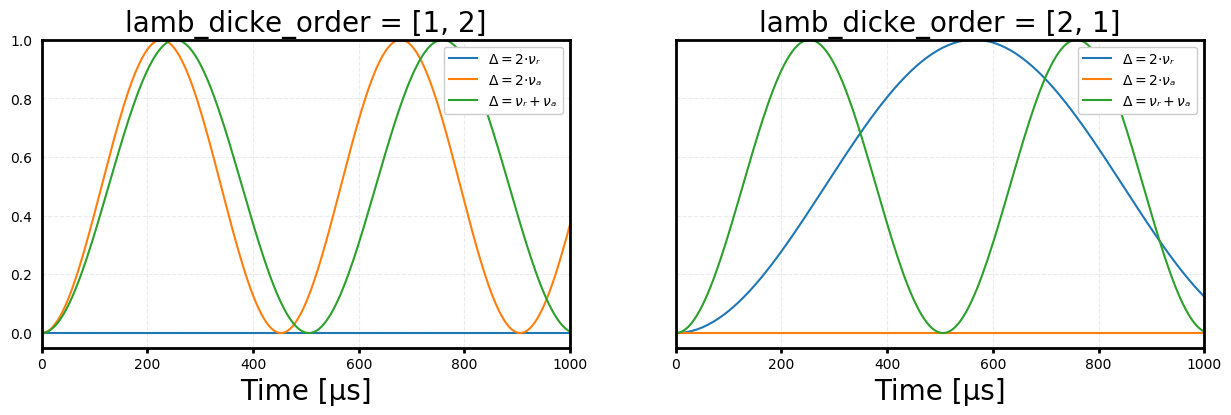Ion-laser interactions mediated by multiple vibrational modes
Contents
Ion-laser interactions mediated by multiple vibrational modes#
using QuantumOptics
using IonSim
using Pkg;
Pkg.add("DSP")
Pkg.add("LaTeXStrings")
using DSP: periodogram
using LaTeXStrings
import PyPlot
const plt = PyPlot
PyPlot
# set some plot configs
plt.matplotlib.rc("xtick", top=false)
plt.matplotlib.rc("ytick", right=false, left=false)
plt.matplotlib.rc("axes", labelsize=20, titlesize=20, grid=true)
plt.matplotlib.rc("axes", linewidth=2)
plt.matplotlib.rc("grid", alpha=0.25, linestyle="--")
plt.matplotlib.rc("font", family="Palatino", weight="medium")
plt.matplotlib.rc("figure", figsize=(8,4))
plt.matplotlib.rc("xtick.major", width=2)
plt.matplotlib.rc("ytick.major", width=2)
Introduction#
In this notebook we will demonstrate that the simulation correctly models laser-mediated interactions between different vibrational modes in a linear chain of ions.
We consider a system consisting of a two-level ion, an axial vibrational mode, a radial vibrational mode and a laser.
Construct the system#
# Setup system
ca = Ca40([("S1/2", -1/2, "S"), ("D5/2", -1/2, "D")])
laser = Laser()
νᵣ = √14 * 1e6 # radial trap frequency
νₐ = 1.5e6 # axial trap frequency
chain = LinearChain(
ions=[ca],
comfrequencies=(x=νᵣ, y=νᵣ, z=νₐ),
selectedmodes=(x=[1], z=[1]),
N = 8
)
chamber = Chamber(iontrap=chain, B=4e-4, Bhat=ẑ, δB=0, lasers=[laser])
# set laser parameters
wavelength_from_transition!(laser, ca, ("S", "D"), chamber)
polarization!(laser, ẑ)
wavevector!(laser, (x̂ + ẑ)/√2)
# set carrier transition Rabi frequency to 500 kHz
intensity_from_rabifrequency!(1, 5e5, 1, ("S", "D"), chamber);
axial = zmodes(chamber)[1]
radial = xmodes(chamber)[1]
ρᵢ_ion = dm(ca["S"])
ρᵢ_axial = thermalstate(axial, 0.5)
ρᵢ_radial = thermalstate(radial, 0.5)
# Set initial state to ρᵢ = |↓, n̄ᵣ=0.5, n̄ₐ=0.5⟩
ρᵢ = ρᵢ_ion ⊗ ρᵢ_radial ⊗ ρᵢ_axial;
Measure ion spectrum#
Warning
Running this scan takes a while (more than 15 minutes).
tspan = 0:10:400
fout(t, ρ) = real(expect(ionprojector(chamber, "D"), ρ))
J = (-dm(ca["S"]) + dm(ca["D"])) ⊗ one(radial) ⊗ one(axial) # Collapse operator
γ = 1e4 * 1e-6
# Scan laser detuning
Δlist = range(νₐ, stop=2νᵣ + 1e5, length=300)
exclist = []
for Δ in Δlist
detuning!(laser, Δ)
h = hamiltonian(chamber, timescale=1e-6, rwa_cutoff=1.5e6, lamb_dicke_order=2)
_, sol = timeevolution.master_dynamic(tspan, ρᵢ, (t, ρ) -> (h(t, ρ), [J], [J], [γ]), fout=fout)
push!(exclist, real(sol[end]))
end
plt.plot(@.((Δlist) / 1e6) , exclist)
plt.text(νₐ/1e6 + 0.1, 0.45, L"νₐ", fontsize=15)
plt.text(νᵣ/1e6 + 0.1, 0.45, L"νᵣ", fontsize=15)
plt.text(2νₐ/1e6, 0.2, L"2⋅νₐ", fontsize=15)
plt.text(2νᵣ/1e6 - 0.3, 0.125, L"2⋅νᵣ", fontsize=15)
plt.text((νᵣ + νₐ)/1e6 + 0.1, 0.3, L"νᵣ + νₐ", fontsize=15)
plt.text((νᵣ - νₐ)/1e6 - 0.1, 0.05, L"νᵣ - νₐ", fontsize=15)
plt.xlim((Δlist[1]) / 1e6, (Δlist[end]) / 1e6 + 0.01)
plt.ylim(-0.01, 0.5)
plt.xlabel("Detuning relative to carrier (MHz)")
plt.ylabel("Excitation")
plt.show()
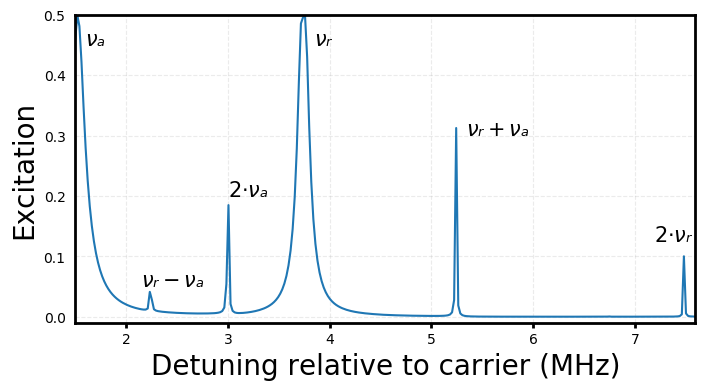
Single phonon interactions#
Now we drive the first-order blue axial sideband of the carrier transition and compare the results for an initial vibrational state of |↓, n̄ᵣ=0, n̄ₐ=1.5⟩ versus |↓, n̄ᵣ=1.5, n̄ₐ=0⟩.
# set carrier transition Rabi frequency to 1 MHz
intensity_from_rabifrequency!(1, 1e6, 1, ("S", "D"), chamber)
detuning!(laser, frequency(axial))
modecutoff!(axial, 10)
modecutoff!(radial, 10)
h = hamiltonian(chamber, timescale=1e-6, rwa_cutoff=1e4, displacement="truncated", time_dependent_eta=false)
tspan = 0:0.25:800
# Set initial state to |↓, n̄ᵣ=0, n̄ₐ=1.5⟩ and solve
ρᵢ_axial = thermalstate(axial, 1.5)
ρᵢ_radial = thermalstate(radial, 0)
ρᵢ = ρᵢ_ion ⊗ ρᵢ_radial ⊗ ρᵢ_axial
tout, sol_ax = timeevolution.schroedinger_dynamic(tspan, ρᵢ, h, fout=fout)
# Set initial state to |↓, n̄ᵣ=1.5, n̄ₐ=0⟩ and solve
ρᵢ_axial = thermalstate(axial, 0)
ρᵢ_radial = thermalstate(radial, 1.5)
ρᵢ = ρᵢ_ion ⊗ ρᵢ_radial ⊗ ρᵢ_axial
tout, sol_rad = timeevolution.schroedinger_dynamic(tspan, ρᵢ, h, fout=fout);
plt.plot(tout, sol_ax, label="n̄_axial=1.5, n̄_radial=0")
plt.plot(tout, analytical.rabiflop.(tout, 1, lambdicke(axial, ca, laser), 1.5, s=1), ls="dotted", label="n̄_axial=1.5, n̄_radial=0 (theoretical)")
plt.plot(tout, sol_rad, alpha=0.5, label="n̄_axial=0, n̄_radial=1.5", zorder=-1)
plt.legend(loc=4, framealpha=1)
plt.ylim(0, 1)
plt.xlim(0, tout[end])
plt.xlabel("Time (μs)")
plt.show()
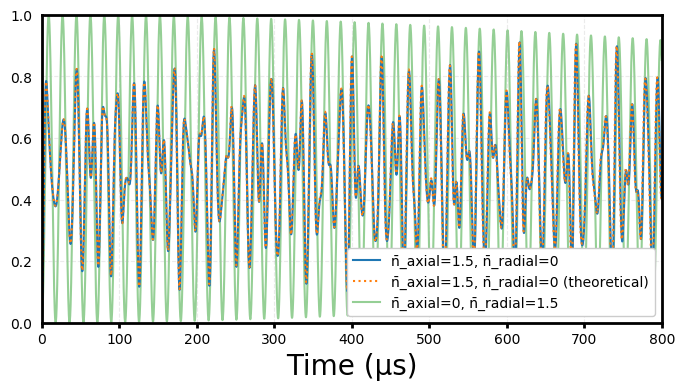
We see (blue curve) that, when the axial mode begins in a thermal state with mean occupation of 1.5 quanta, the oscillations exhibit a large spectral content – since the coupling strength of the sideband transition depends strongly on the occupation of the mode. The dotted orange curve is the theoretical prediction.
On the other hand, when the axial mode begins in its ground state but the radial mode begins in a thermal state with mean occupation 1.5 quanta, we see (green curve) that the dominant effect is a slow decay. To first order, this is described by an n-dependent dispersive shift of the axial sideband transition due to off-resonant interaction with the radial mode.
If we instead drive the radial sideband, we produce analogous results:
tspan = 0:0.25:800
detuning!(laser, frequency(radial))
h = hamiltonian(chamber, timescale=1e-6, rwa_cutoff=1e4)
# Set initial state to |↓, n̄ᵣ=0, n̄ₐ=1.5⟩ and solve
ρᵢ_axial = thermalstate(axial, 1.5)
ρᵢ_radial = thermalstate(radial, 0)
ρᵢ = ρᵢ_ion ⊗ ρᵢ_radial ⊗ ρᵢ_axial
tout, sol_ax = timeevolution.schroedinger_dynamic(tspan, ρᵢ, h, fout=fout)
# Set initial state to |↓, n̄ᵣ=1.5, n̄ₐ=0⟩ and solve
ρᵢ_axial = thermalstate(axial, 0)
ρᵢ_radial = thermalstate(radial, 1.5)
ρᵢ = ρᵢ_ion ⊗ ρᵢ_radial ⊗ ρᵢ_axial
tout, sol_rad = timeevolution.schroedinger_dynamic(tspan, ρᵢ, h, fout=fout);
plt.plot(tout, sol_rad, label="n̄_axial=0, n̄_radial=1.5")
plt.plot(tout, analytical.rabiflop.(tout, 1, lambdicke(radial, ca, laser), 1.5, s=1), ls="dotted", label="n̄_axial=0, n̄_radial=1.5 (theoretical)")
plt.plot(tout, sol_ax, alpha=0.5, label="n̄_axial=1.5, n̄_radial=0", zorder=-1)
plt.legend(loc=4, framealpha=1)
plt.ylim(0, 1)
plt.xlim(0, tout[end])
plt.xlabel("Time (μs)")
plt.show()
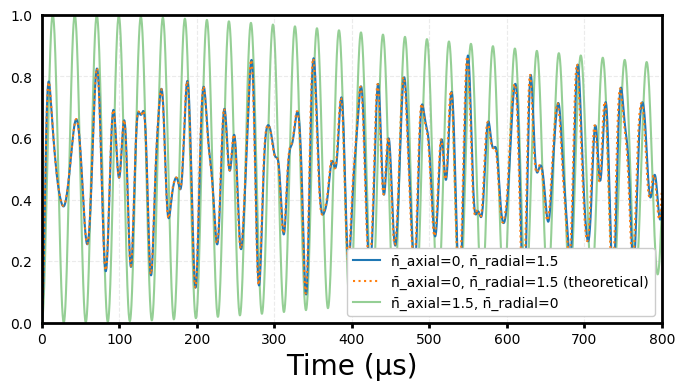
The main difference between this and the previous plot (aside from the role-reversal of the vibrational modes) is that the coupling strengths are all scaled down since the Lamb Dicke factor for the radial mode is smaller (η ∝ 1/√ν).
Two phonon interactions#
Finally, we set the laser detuning equal to the carrier transition plus the sum of the two trap frequencies. In this case, we drive a second-order sideband transition that involves simultaneously increasing the occupation numbers of both modes by one quanta.
fout(t, ρ) = real(expect(ionprojector(chamber, "D"), ρ));
tspan = 0:1:10000
modecutoff!(axial, 15)
modecutoff!(radial, 15)
detuning!(laser, frequency(radial) + frequency(axial))
h = hamiltonian(chamber, timescale=1e-6, rwa_cutoff=1e4)
# Set initial state to |↓, n̄ᵣ=0, n̄ₐ=1.5⟩
ρᵢ_axial = thermalstate(axial, 1.5)
ρᵢ_radial = thermalstate(radial, 0)
ρᵢ = ρᵢ_ion ⊗ ρᵢ_radial ⊗ ρᵢ_axial
tout, sol_ax = timeevolution.schroedinger_dynamic(tspan, ρᵢ, h, fout=fout)
# Set initial state to |↓, n̄ᵣ=1.5, n̄ₐ=0⟩ and solve
ρᵢ_axial = thermalstate(axial, 0)
ρᵢ_radial = thermalstate(radial, 1.5)
ρᵢ = ρᵢ_ion ⊗ ρᵢ_radial ⊗ ρᵢ_axial
tout, sol_rad = timeevolution.schroedinger_dynamic(tspan, ρᵢ, h, fout=fout)
# Set initial state to |↓, n̄ᵣ=1.5, n̄ₐ=1.5⟩ and solve
ρᵢ_axial = thermalstate(axial, 1.5)
ρᵢ_radial = thermalstate(radial, 1.5)
ρᵢ = ρᵢ_ion ⊗ ρᵢ_radial ⊗ ρᵢ_axial
tout, sol_ax_rad = timeevolution.schroedinger_dynamic(tspan, ρᵢ, h, fout=fout);
plt.plot(tout, sol_rad, label="n̄_axial=0, n̄_radial=1.5")
plt.plot(tout, sol_ax, label="n̄_axial=1.5, n̄_radial=0")
plt.plot(tout, sol_ax_rad, label="n̄_axial=1.5, n̄_radial=1.5")
plt.legend(loc=1, framealpha=1)
plt.ylim(0, 1)
plt.xlim(0, tout[10000])
plt.xlabel("Time (μs)")
plt.show()

In this case the results for ρᵢ = |↓, n̄ᵣ=0, n̄ₐ=1.5⟩ and ρᵢ = |↓, n̄ᵣ=1.5, n̄ₐ=0⟩ are very similar and ρᵢ = |↓, n̄ᵣ=1.5, n̄ₐ=1.5⟩ is significantly different.
It’s illustrative to look at these results in frequency space:
ηᵣ = lambdicke(radial, ca, laser)
ηₐ = lambdicke(axial, ca, laser)
η2 = ηᵣ * ηₐ
P(n1, n2; n̄₁=1.5, n̄₂=1.5) = n̄₁^n1 * n̄₂^n2 / ((n̄₁ + 1)^(n1 + 1) * (n̄₂ + 1)^(n2 + 1))
sample_rate = (length(tout) - 1) / tout[end]
pwarray1 = periodogram(convert(Array{Float64}, sol_ax_rad), fs=sample_rate)
p1 = sqrt.(pwarray1.power[2:length(pwarray1.power) ÷ 2])
f1 = pwarray1.freq[2:length(pwarray1.power) ÷ 2]
pwarray2 = periodogram(convert(Array{Float64}, sol_rad), fs=sample_rate)
p2 = sqrt.(pwarray2.power[2:length(pwarray2.power) ÷ 2])
f2 = pwarray2.freq[2:length(pwarray2.power) ÷ 2]
fig, ax = plt.subplots()
plt.plot(f2, p2, label=L"n̄ₐ=0, n̄ᵣ=1.5 (simulation)")
plt.plot(f1, p1, label=L"n̄ₐ=1.5, n̄ᵣ=1.5 (simulation)")
bins = [η2 * √i for i in 1:9]
nlist = []
for n in 1:9
templist = []
for i in 0:9, j in 0:9
if (i + 1) * (j + 1) == n
push!(templist, (i, j))
end
end
push!(nlist, templist)
end
double_thermal = [sum([P(n...) for n in nl]) for nl in nlist]
single_thermal = [P(n, 0) for n in 0:8]
plt.bar(
bins, double_thermal .* maximum(p1)/double_thermal[2],
width=0.0002, alpha=0.25, color="C1",
label=L"n̄ₐ=1.5, n̄ᵣ=1.5 (theory)"
)
plt.bar(
bins, single_thermal .* maximum(p2)/single_thermal[1],
width=0.0002, alpha=0.25, color="C0",
label=L"n̄ₐ=0, n̄ᵣ=1.5 (theory)"
)
ax.set_xticks(bins)
ax.set_xticklabels([L"ηᵣ⋅ηₐ", L"√2⋅ηᵣ⋅ηₐ", L"√3⋅ηᵣ⋅ηₐ", L"2⋅ηᵣ⋅ηₐ", L"√5⋅ηᵣ⋅ηₐ", L"√6⋅ηᵣ⋅ηₐ", L"√7⋅ηᵣ⋅ηₐ", L"√8⋅ηᵣ⋅ηₐ", L"3⋅ηᵣ⋅ηₐ"], rotation=40)
ax.set_yticklabels([])
plt.xlim(0.0018, 0.006)
plt.xlabel("Frequency [2π/Ω_carrier]")
plt.ylabel("Spectral Weights [abu]")
plt.legend(loc=1)
plt.show()
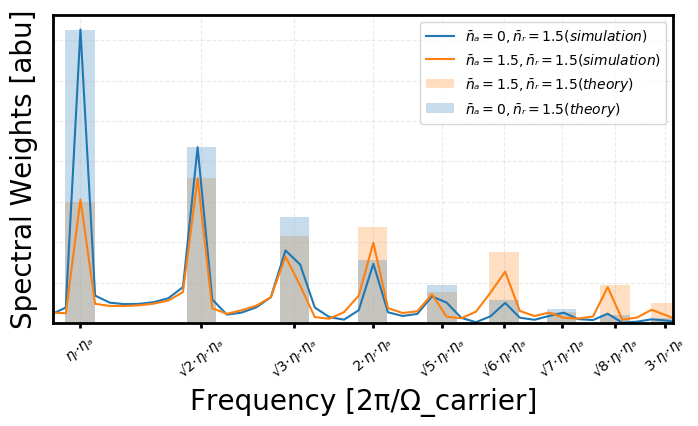
lamb_dicke_order as a vector#
As a final note we mention that, when more than one vibrational mode is present in the simulation, we can indepently set the order of the Lamb-Dicke approximation for each mode by inputing a vector V to the keyword argument lamb_dicke_order in the hamiltonian function. In this case, typeof(V) ≡ Vector{<:Int} and the length of V must be equal to the number of modes.
tspan = 0:5:1000
ρᵢ_axial = thermalstate(axial, 0)
ρᵢ_radial = thermalstate(radial, 0)
ρᵢ = ρᵢ_ion ⊗ ρᵢ_radial ⊗ ρᵢ_axial # Set initial state to |↓, n̄ᵣ=0, n̄ₐ=0⟩
detuning!(laser, 2*frequency(radial)) # Set detuning to second order radial sideband
h = hamiltonian(chamber, timescale=1e-6, rwa_cutoff=1e4, lamb_dicke_order=[1, 2]) # First order LD approx on radial mode and second order on axial mode
tout, sol_rad = timeevolution.schroedinger_dynamic(tspan, ρᵢ, h, fout=fout)
detuning!(laser, 2*frequency(axial)) # Set detuning to second order axial sideband
h = hamiltonian(chamber, timescale=1e-6, rwa_cutoff=1e4, lamb_dicke_order=[1, 2])
tout, sol_ax = timeevolution.schroedinger_dynamic(tspan, ρᵢ, h, fout=fout)
detuning!(laser, frequency(radial) + frequency(axial)) # Set detuning to axial + radial sideband
h = hamiltonian(chamber, timescale=1e-6, rwa_cutoff=1e4, lamb_dicke_order=[1, 2])
tout, sol_rad_ax = timeevolution.schroedinger_dynamic(tspan, ρᵢ, h, fout=fout)
detuning!(laser, 2*frequency(radial)) # Set detuning to second order radial sideband
h = hamiltonian(chamber, timescale=1e-6, rwa_cutoff=1e4, lamb_dicke_order=[2, 1]) # First order LD approx on radial mode and second order on axial mode
tout, sol_radr = timeevolution.schroedinger_dynamic(tspan, ρᵢ, h, fout=fout)
detuning!(laser, 2*frequency(axial)) # Set detuning to second order axial sideband
h = hamiltonian(chamber, timescale=1e-6, rwa_cutoff=1e4, lamb_dicke_order=[2, 1])
tout, sol_axr = timeevolution.schroedinger_dynamic(tspan, ρᵢ, h, fout=fout)
detuning!(laser, frequency(radial) + frequency(axial)) # Set detuning to axial + radial sideband
h = hamiltonian(chamber, timescale=1e-6, rwa_cutoff=1e4, lamb_dicke_order=[2, 1])
tout, sol_rad_axr = timeevolution.schroedinger_dynamic(tspan, ρᵢ, h, fout=fout);
fig, ax = plt.subplots(1, 2, sharey=true, figsize=(15, 4))
ax[1].plot(tout, sol_rad, label=L"Δ = 2⋅νᵣ")
ax[1].plot(tout, sol_ax, label=L"Δ = 2⋅νₐ")
ax[1].plot(tout, sol_rad_ax, label=L"Δ = νᵣ + νₐ")
ax[1].legend(loc=1, framealpha=1)
ax[1].set_title("lamb_dicke_order = [1, 2]")
ax[2].plot(tout, sol_radr, label=L"Δ = 2⋅νᵣ")
ax[2].plot(tout, sol_axr, label=L"Δ = 2⋅νₐ")
ax[2].plot(tout, sol_rad_axr, label=L"Δ = νᵣ + νₐ")
ax[2].set_title("lamb_dicke_order = [2, 1]")
ax[2].legend(loc=1, framealpha=1)
plt.ylim(-0.05, 1)
ax[1].set_xlim(0, tout[end]); ax[2].set_xlim(0, tout[end])
ax[1].set_xlabel("Time [μs]"); ax[2].set_xlabel("Time [μs]")
plt.show()
